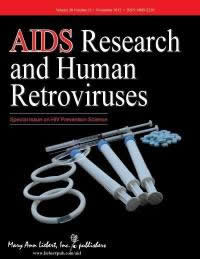
|
HIV and AIDS prevention
- Progress and the challenges ahead
 New Rochelle, NY, November 5, 2012 - At least 2 million people worldwide will be infected with HIV this year,
driving the need for better HIV prevention strategies to slow the global pandemic. A better understanding of how to prevent HIV transmission
using antiviral drugs led to approval of the first oral pill for HIV prevention, and microbicides delivered as topical gels or via
intravaginal rings are in clinical testing and have yielded both positive and negative results. The complex factors involved
in the sexual transmission of HIV, the urgent need for new preventive approaches, and the most promising methods currently
in development are examined in a special issue of AIDS Research and Human Retroviruses, a peer-reviewed journal published
by Mary Ann Liebert, Inc, publishers. The entire issue is available free on the AIDS Research and Human Retroviruses
website at http://www.liebertpub.com/aid. New Rochelle, NY, November 5, 2012 - At least 2 million people worldwide will be infected with HIV this year,
driving the need for better HIV prevention strategies to slow the global pandemic. A better understanding of how to prevent HIV transmission
using antiviral drugs led to approval of the first oral pill for HIV prevention, and microbicides delivered as topical gels or via
intravaginal rings are in clinical testing and have yielded both positive and negative results. The complex factors involved
in the sexual transmission of HIV, the urgent need for new preventive approaches, and the most promising methods currently
in development are examined in a special issue of AIDS Research and Human Retroviruses, a peer-reviewed journal published
by Mary Ann Liebert, Inc, publishers. The entire issue is available free on the AIDS Research and Human Retroviruses
website at http://www.liebertpub.com/aid.
Guest Editor Patrick Kiser, University of Utah, Salt Lake City, and coauthors Pedro Mesquita and Betsy Herold, Albert
Einstein College of Medicine, New York, NY, provide an overview of the scientific and developmental gaps in the field of drug
discovery, formulation, and delivery to prevent sexual transmission of HIV. In the article "A Perspective on Progress and
Gaps in HIV Prevention Science," they review the prophylactic agents in development and their advantages and limitations,
and they present recommendations for future research directions. "The advances we are seeing today are exciting and
justify a continued focus on the science and technologies that can make a difference in this public health crisis," says Dr. Kiser.
Peter Anton and coauthors, David Geffen School of Medicine at UCLA and the School of Public Health
(Los Angeles, CA), University of Pittsburgh and Medical School (PA), University of North Carolina, Chapel Hill,
Johns Hopkins University School of Medicine (Baltimore, MD), Alpha StatConsult (Damascus, MD), Columbia
University (New York, NY), and CONRAD (Arlington, VA), compared the oral and topical administration
of the microbicide tenofovir, given as a pill or rectal gel. A mucosal tissue sample was
removed from each participant and exposed to HIV to assess if treatment prevented
infection. While the patients preferred the oral drug, one-time rectal exposure
to the microbicide led to 6-10 times greater drug concentrations in the
sampled tissue, and this correlates with reduced infectibility.
Line Vibholm and colleagues from Aarhus University and Aarhus University Hospital, Denmark, present the results of
a study designed to evaluate in a female mouse model the effects of a topical gel containing 1% tenofovir, a
microbicide previously shown to reduce substantially the transmission of both HIV and herpes simplex
virus (HSV). In "Antiviral and Immunological Effects of Tenofovir Microbicide in Vaginal Herpes
Simplex Virus 2 Infection," the authors provide data to support the suitability of this model
for testing future microbicidal drug candidates.
"It is currently an exciting time in HIV prevention science research, with progress on multiple fronts," says Thomas
Hope, PhD, Editor-in-Chief of AIDS Research and Human Retroviruses and Professor of Cell and Molecular Biology at
the Feinberg School of Medicine, Northwestern University, Chicago, IL. "We are proud to feature this work in the
special issue and, in the future, to report critical advances to bring the field closer to the goal of
decreasing the rate of HIV transmission around the world."
###
About the Journal
AIDS Research and Human Retroviruses is published monthly in print and online. It contains papers, reviews, and case studies documenting
the latest developments and research advances in the molecular biology of HIV and SIV and innovative approaches to HIV vaccine and
therapeutic drug research, including the development of antiretroviral agents and immune-restorative therapies. The content also
explores the molecular and cellular basis of HIV pathogenesis and HIV/HTLV epidemiology. The Journal features rapid publication
of emerging sequence information and reports on clinical trials of emerging HIV therapies. Tables of content and a sample
issue may be viewed on the AIDS Research and Human Retroviruses website at http://www.liebertpub.com/aid.
About the Publisher
Mary Ann Liebert, Inc., publishers is a privately held, fully integrated media company known for establishing authoritative
peer-reviewed journals in many promising areas of science and biomedical research, including AIDS Patient Care and STDs, Viral
Immunology, and Journal of Interferon and Cytokine Research. Its biotechnology trade magazine, Genetic Engineering &
Biotechnology News (GEN), was the first in its field and is today the industry's most widely read publication worldwide.
A complete list of the firm's 70 journals, books, and newsmagazines is available on the Mary Ann Liebert, Inc.,
publishers website at http://www.liebertpub.com .
Mary Ann Liebert, Inc. 140 Huguenot St., New Rochelle, NY 10801-5215 www.liebertpub.com
Phone: (914) 740-2100 (800) M-LIEBERT Fax: (914) 740-2101
Contact:
Vicki Cohn
vcohn@liebertpub.com
914-740-2100
Mary Ann Liebert, Inc./Genetic Engineering News
Source:
http://www.eurekalert.org/pub_releases/2012-11/mali-haa110512.php
For more HIV and AIDS News visit...
Positively Positive - Living with HIV/AIDS:
HIV/AIDS News |